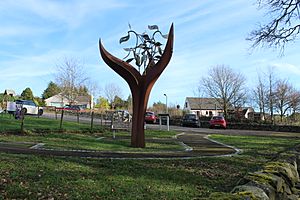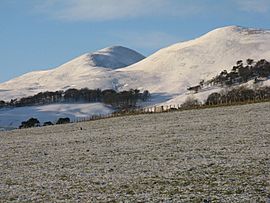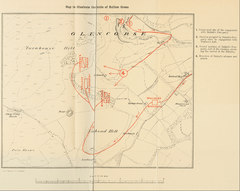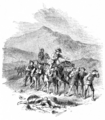Battle of Rullion Green facts for kids
Quick facts for kids Battle of Rullion Green |
|||||||
|---|---|---|---|---|---|---|---|
| Part of Scottish Covenanter Wars | |||||||
 The Dalry Covenanter Sculpture which commemorates the uprising |
|||||||
|
|||||||
| Belligerents | |||||||
| Commanders and leaders | |||||||
| Strength | |||||||
| 2,000 – 3,000 | 750 – 1,100 | ||||||
| Casualties and losses | |||||||
| light |
|
||||||
| Designated | 30 November 2011 | ||||||
| Reference no. | BTL27 | ||||||
The Battle of Rullion Green happened on 28 November 1666. It took place near the Pentland Hills in Scotland. This battle was the most important fight of the Pentland Rising. This was a short rebellion by a group called the Covenanters. They were unhappy with the Scottish government.
The Covenanters were fighting against changes to the Church of Scotland. They did not like that bishops were brought back into the church. A Covenanter army, led by Colonel James Wallace, fought against government forces. The government army was led by Tam Dalyell of the Binns. The Covenanters lost the battle.
Not many people died in the battle itself. About 40 to 50 Covenanters were killed. Many prisoners were taken, and some were later executed. Others were sent far away to Barbados. Even after this battle, there was still unrest in Scotland for many years. This led to a difficult time from 1679 to 1688, known as The Killing Time.
Contents
Why did the Pentland Rising begin?
After the king returned to power in Scotland in 1660, the government made changes to the Church of Scotland. They brought back bishops, which many people did not like. Many church leaders, called ministers, refused to accept these changes. About 270 ministers lost their jobs because of this.
Most of these ministers were in the southwest of Scotland. This area strongly supported the Covenanters. These ministers started holding church services outdoors in fields. These meetings were called Conventicles, and thousands of people would often attend.
The Covenanters had been involved in earlier conflicts. Because of this, the government saw them as a threat. The government tried different ways to deal with them. Sometimes they were harsh, and sometimes they were more forgiving. In 1663, ministers who disagreed with the government were called 'seditious persons'. People who did not attend the official church services faced big fines.
Scotland also had strong ties with the Dutch Republic. When a war started between England and the Dutch in 1665, the Scottish government became even more worried about the Covenanters. The war also made the Scottish economy much worse.
Government soldiers, led by General James Turner, were sent to the southwest. They were there to make sure people followed the rules. The Pentland Rising began on 12 November 1666 in St. John's Town of Dalry. It is said that the uprising started when Covenanters saw soldiers bothering an old man. They were trying to collect a fine from him.
The Covenanters, led by Robert McClellan, took the soldiers' weapons. A similar event happened in the nearby village of Balmaclellan. McClellan knew this would cause trouble. He gathered his men and went to Dumfries, where they captured General Turner.
Some people believe the uprising was planned for months. Meetings were held by church leaders in Edinburgh. When the rising began, experienced soldiers like James Wallace of Auchens joined to lead the rebels.
Many people were careful about joining the rebellion. The government had already arrested some important Covenanters. But the number of rebels quickly grew to about 700. Many were poor workers or artisans who were struggling. They were motivated by their strong religious beliefs and hard economic times.
The leaders included ministers like William Veitch and John Welsh. There were also some unhappy landowners like McClellan. On 21 November, Wallace took command of the rebel army. Joseph Learmont became his second-in-command.
The rebels first planned to go to Glasgow, a city that supported them. But a government army blocked their way. So, they marched towards Edinburgh instead. They hoped to give a petition to the Scottish government there. They also hoped to get more people to join them.
By 26 November, their numbers had grown to 1,100 when they reached Lanark. They publicly signed the Covenant there. The next day, they moved to Colinton, just outside Edinburgh. But they could not enter the city. Many of their men were very tired from marching for two weeks in winter.
With their path to the west blocked by Dalyell's army, Wallace moved his forces. He went east and then south along the Pentland Hills. They stopped near Rullion Green to wait for others to catch up. Here, they were met by government cavalry. These cavalry were led by William Drummond, Dalyell's deputy.
How the Battle of Rullion Green unfolded
Drummond's cavalry were pushed back by the Covenanters. But the main government army was very close, only four miles away. The Covenanters could not escape. Wallace arranged his troops on high ground above the Glencorse River. He waited while Dalyell prepared his soldiers for battle.
The Covenanter left side was attacked three times. Each time, they fought back successfully. A fourth attack happened late in the afternoon. At this point, a small group of Covenanter cavalry moved across the battlefield. They wanted to help their left side. But this left their right side open to attack.
Seeing this chance, Drummond attacked the exposed Covenanter right. The Covenanters were outnumbered and under pressure from all sides. Their position broke, and they ran away into the night. About 50 Covenanters died, many during the chase that followed.
Some leaders managed to escape. Wallace went to the Netherlands and died there later. Learmont was hidden by supporters and returned to Scotland to fight again. Veitch and Welsh also avoided capture and remained important Covenanter leaders.
What happened after the battle?
Some of the Covenanter leaders had been involved in earlier plots. The government believed there might be a bigger plan. They thought Covenanters in Scotland and Ireland might be working together. They also worried about support from the Dutch. This might explain why the government reacted so harshly.
A few leaders were caught. These included John Neilson and Hugh Mackail, a young preacher. Both were questioned for information before being executed in December. In total, 36 prisoners were executed in different towns. The rest were sent to Barbados.
The rising itself did not change much right away. But the government, led by Lauderdale, first tried to be more understanding. However, they soon started persecuting the Covenanters again. This continued for the next two decades. It led to a very difficult time from 1679 to 1688, known as The Killing Time.
Those who were executed became known as Covenanter martyrs. People remembered them, and their graves were marked with memorials later on.
Fiction
- Galt, John. Ringan Gilhaize, 1823
Images for kids




